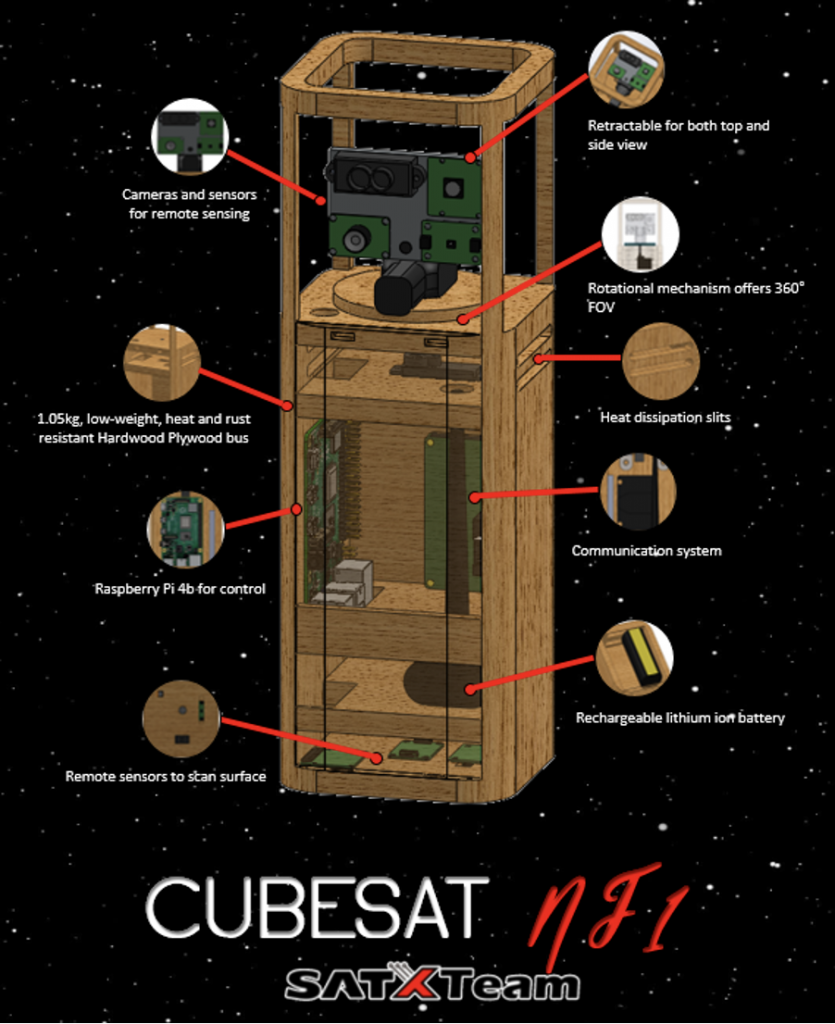Congratulations to the SatXTeam for their success in the UKSEDs Satellite Design Competition with their satellite Cubesat NF1.
SatXTeam, in collaboration with AstRoSoc, was founded in December 2020 and the team’s primary goal was to participate in the UKSEDS Satellite Design Competition. The team was composed of first and second year STEM undergraduate students who study at the University of Leicester. This was the team’s first time taking part in the Satellite Design Competition.

SatXTeam’s mission was to design a CubeSat that would be launched into lunar orbit to detect, identify, analyse and relay information regarding targeted Lunar landmarks. The mission was split into three stages namely the preliminary, critical and extended design phases. The first two stages saw the development of a nanosatellite for a simulated lunar environment while the later stage extended into an actual lunar environment.
The mission requirements incorporated a payload mass budget of 6kg and a volume constraint of 3U. The mission entailed designing independent subsystems whilst utilizing legal frequencies and ensuring that the satellite was fully operational remotely. Similarly, testing and simulations were necessitated for validation whereas complying with environmental and safety standards was expected.
The CubeSat was fully designed and modelled on Solidworks and was called NF1, which stood for Nifty Fridge One since the early prototype design resembled a small fridge. The final CAD model was achieved through several customizations and evolutions. From the first prototype designed in December 2020, the CubeSat evolved morphologically with modifications to the volume, structure, mechanisms and much more resulting in a final fully-optimized model. One of the greatest innovations within the project had been the choice of material. Hardwood Plywood was opted as the main material for the satellite bus since it was economical, sustainable, light-weight and was more than adequate for a simulated lunar environment.

Various subsystems had been developed and integrated within the CubeSat making it capable of identifying:
● Objects of interest
● Thermal sources
● Light sources
● EM signals
In comparison to the preliminary and critical design stages where the cubesat was designed to operate in a simulated lunar environment, for the final extended phase, significant changes have been enforced to account for an actual space environment. These included the change of material, addition of a propulsion system and various amendments in payload components to furnish the cubesat for lunar orbit.

The final cubesat, designed for a lunar mission to capture high quality data, was equipped with space-graded, state-of-the-art sensors and instruments.
The platform design was not only compact and light-weight, but also offered an economical budget thanks to shorter development time and reduced launch costs. Considering all the benefits of the cubesat platform, the team concluded that their cubesat mission was worth pursuing and a larger platform would not be required.
Within the competition, over the course of the year, SatXTeam produced three design reports and took part in a competition day where the team demonstrated their work in a live presentation. With all the marks summed up across all stages, SatXTeam won an overall 3rd place in the competition.
Team Members
James Orme, Mohammed Siddiqui, Zainab Bikar, Fiona Poda, Augustus Barteska, Kishen Pankhania, Dan Morley.

 Subscribe to Physics & Astronomy's posts
Subscribe to Physics & Astronomy's posts
Recent Comments